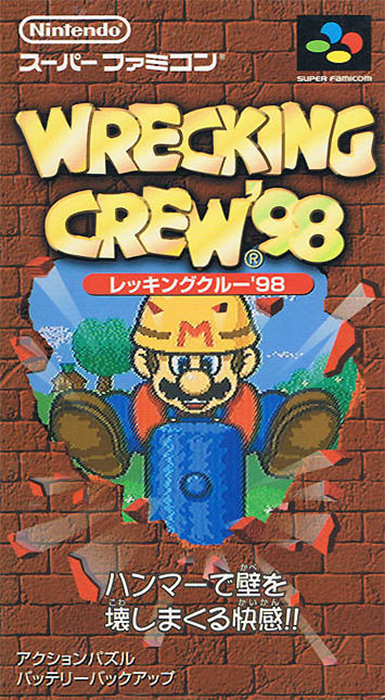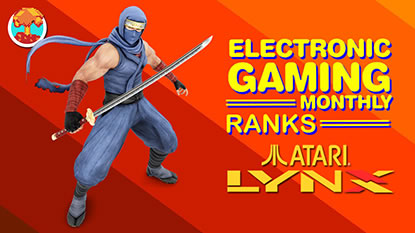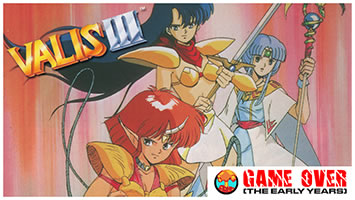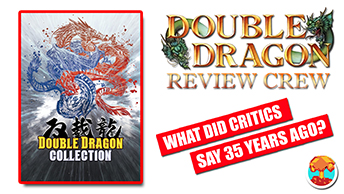- CLASSIC MAGAZINES
- REVIEW CREW
A show recapping what critics thought back
when classic games first came out! - NEXT GENERATION'S BEST & WORST
From the worst 1-star reviews to the best
5-stars can offer, this is Next Generation! - NINTENDO POWER (ARCHIVE)
Experience a variety of shows looking at the
often baffling history of Nintendo Power! - MAGAZINE RETROSPECTIVE
We're looking at the absolutely true history of
some of the most iconic game magazines ever! - SUPER PLAY'S TOP 600
The longest and most ambitious Super NES
countdown on the internet! - THEY SAID WHAT?
Debunking predictions and gossip found
in classic video game magazines! - NEXT GENERATION UNCOVERED
Cyril is back in this spin-off series, featuring the
cover critic review the art of Next Generation! - HARDCORE GAMER MAGAZING (PDF ISSUES)
Download all 36 issues of Hardcore Gamer
Magazine and relive the fun in PDF form!
- REVIEW CREW
- ELECTRONIC GAMING MONTHLY
- ELECTRONIC GAMING MONTHLY RANKS
From Mario to Sonic to Street Fighter, EGM
ranks classic game franchises and consoles! - ELECTRONIC GAMING MONTHLY BEST & WORST
Counting down EGM’s best and worst reviews
going year by year, from 1989 – 2009! - ELECTRONIC GAMING BEST & WORST AWARDS
11-part video series chronicling the ups and
downs of EGM’s Best & Worst Awards!
- ELECTRONIC GAMING MONTHLY RANKS
- GAME HISTORY
- GAME OVER: STORY BREAKDOWNS
Long-running series breaking down game
stories and analyzing their endings! - A BRIEF HISTORY OF GAMING w/ [NAME HERE]
Real history presented in a fun and pithy
format from a variety of game historians! - THE BLACK SHEEP
A series looking back at the black sheep
entries in popular game franchises! - INSTANT EXPERT
Everything you could possibly want to know
about a wide variety of gaming topics! - FREEZE FRAME
When something familiar happens in the games
industry, we're there to take a picture! - I'VE GOT YOUR NUMBER
Learn real video game history through a series
of number-themed episodes, starting at zero! - GREAT MOMENTS IN BAD ACTING
A joyous celebration of some of gaming's
absolute worst voice acting!
- GAME OVER: STORY BREAKDOWNS
- POPULAR SHOWS
- DG NEWS w/ LORNE RISELEY
Newsman Lorne Riseley hosts a regular
series looking at the hottest gaming news! - REVIEW REWIND
Cyril replays a game he reviewed 10+ years
ago to see if he got it right or wrong! - ON-RUNNING FEUDS
Defunct Games' longest-running show, with
editorials, observations and other fun oddities! - DEFUNCT GAMES QUIZ (ARCHIVE)
From online quizzes to game shows, we're
putting your video game knowledge to the test!- QUIZ: ONLINE PASS
Take a weekly quiz to see how well you know
the news and current gaming events! - QUIZ: KNOW THE GAME
One-on-one quiz show where contestants
find out if they actually know classic games! - QUIZ: THE LEADERBOARD
Can you guess the game based on the classic
review? Find out with The Leaderboard!
- QUIZ: ONLINE PASS
- DEFUNCT GAMES VS.
Cyril and the Defunct Games staff isn't afraid
to choose their favorite games and more! - CYRIL READS WORLDS OF POWER
Defunct Games recreates classic game
novelizations through the audio book format!
- DG NEWS w/ LORNE RISELEY
- COMEDY
- GAME EXPECTANCY
How long will your favorite hero live? We crunch
the numbers in this series about dying! - VIDEO GAME ADVICE
Famous game characters answer real personal
advice questions with a humorous slant! - FAKE GAMES: GUERILLA SCRAPBOOK
A long-running series about fake games and
the people who love them (covers included)! - WORST GAME EVER
A contest that attempts to create the worst
video game ever made, complete with covers! - LEVEL 1 STORIES
Literature based on the first stages of some
of your favorite classic video games! - THE COVER CRITIC
One of Defunct Games' earliest shows, Cover
Critic digs up some of the worst box art ever! - COMMERCIAL BREAK
Take a trip through some of the best and
worst video game advertisements of all time! - COMIC BOOK MODS
You've never seen comics like this before.
A curious mix of rewritten video game comics!
- GAME EXPECTANCY
- SERIES ARCHIVE
- NINTENDO SWITCH ONLINE ARCHIVE
A regularly-updated list of every Nintendo
Switch Online release, plus links to review! - PLAYSTATION PLUS CLASSIC ARCHIVE
A comprehensive list of every PlayStation
Plus classic release, including links! - RETRO-BIT PUBLISHING ARCHIVE
A regularly-updated list of every Retro-Bit
game released! - REVIEW MARATHONS w/ ADAM WALLACE
Join critic Adam Wallace as he takes us on a
classic review marathon with different themes!- DEFUNCT GAMES GOLF CLUB
Adam Wallace takes to the links to slice his way
through 72 classic golf game reviews! - 007 IN PIXELS
Adam Wallace takes on the world's greatest spy
as he reviews 15 weeks of James Bond games! - A SALUTE TO VAMPIRES
Adam Wallace is sinking his teeth into a series
covering Castlevania, BloodRayne and more! - CAPCOM'S CURSE
Adam Wallace is celebrating 13 days of Halloween
with a line-up of Capcom's scariest games! - THE FALL OF SUPERMAN
Adam Wallace is a man of steel for playing
some of the absolute worst Superman games! - THE 31 GAMES OF HALLOWEEN
Adam Wallace spends every day of October afraid
as he reviews some of the scariest games ever! - 12 WEEKS OF STAR TREK
Adam Wallace boldly goes where no critic has
gone before in this Star Trek marathon!
- DEFUNCT GAMES GOLF CLUB
- DAYS OF CHRISTMAS (ARCHIVE)
Annual holiday series with themed-episodes
that date all the way back to 2001!- 2015: 30 Ridiculous Retro Rumors
- 2014: 29 Magazines of Christmas
- 2013: 29 Questionable Power-Ups of Christmas
- 2012: 34 Theme Songs of Christmas
- 2011: 32 Game Endings of Christmas
- 2010: 31 Bonus Levels of Christmas
- 2009: 30 Genres of Christmas
- 2008: 29 Controls of Christmas
- 2007: 34 Cliches of Christmas
- 2006: 33 Consoles of Christmas
- 2005: 32 Articles of Christmas
- 2004: 31 Websites of Christmas
- 2003: 29 Issues of Christmas
- 2002: 28 Years of Christmas
- 2001: 33 Days of Christmas
- NINTENDO SWITCH ONLINE ARCHIVE
- REVIEW ARCHIVE
- FULL ARCHIVE
Nintendo Switch Online: 1990s Critics Review Super R-Type, Amazing Hebereke and Wrecking Crew '98
For those who thought Nintendo would slow down when it came to their online service, guess again. We're back with yet another big update, and this is a good one. This week we're getting Amazing Hebereke and Wrecking Crew '98, two 16-bit classics that are coming to America for the first time ever. On top of that, shoot ‘em up fans will have something to celebrate, as Super R-Type is hitting the online library. That's exciting news, but are any of these games actually worth playing? To answer that question, I decided to flip through the pages of Electronic Gaming Monthly, Computer & Video Games, Super Play and more classic magazines to see what the critics said back when these games first came out. Get your Force Bit ready, because we're blasting off with another exciting episode of Nintendo Switch Online Review Crew!
Although R-Type was one of the biggest shoot ‘em ups of the 1980s, it somehow never made its way to the Nintendo Entertainment System. This was one of the few times when Sega Master System fans and early TurboGrafx-16 adopters had something big to hang over the heads of their NES-owning friends, as this horror-themed shooter is a legitimate classic. But don't worry, Nintendo fans, because Irem had you covered with Super R-Type, an early generation Super NES game that was essentially a 16-bit reworking of R-Type 2. While not as iconic as the original, this sequel still gave us a taste of what made the series so great in the first place, including gorgeous levels and cool bosses that were clearly inspired by the artwork of H.R. Giger. Best of all, the Force Bit is back and just as much to play with. This was always the key to R-Type's success. It was a round shield that could be attached to any side of your craft, as well as flung at enemies like a projectile. It worked as both an offensive and defensive helper, quite literally shielding the player from bullets and bad guys. That said, this game has a reputation for being extremely tough and full of those annoying slowdowns that plagued Super NES games in the early days. Let's see how that impacts the opinions and scores from back when Super R-Type came out.
As we so often do, we're going to start with Electronic Gaming Monthly, who ends up being perched right in the middle of the Super R-Type divide. They ultimately liked the game, giving it a solid average of 8 out of 10. Ed called it “Easily the best Super NES shooter on the market. But, it appears that it is too good. Whether the massive slowdown is due to the slow CPU in the Super NES or inexperienced programmers, it is major! Stunning graphics, fantastic weapons and huge bosses make it a sight to see, though.” Steve agreed, calling Super R-Type a “hodge-podge of the very best from both the arcade games with a large cup of new material thrown in for good measure. It's too easy and too short, but the trip is spectacular.”
EGM's 8 out of 10 score basically lines up with a lot of critics at the time, including GamePro, who gave the game a 4 out of 5 back in November 1991. You also saw a similar score from Nintendo Magazine System, who went with a slightly higher 82%. On the lower side, you have Nintendo Power giving the a 3.5 out of 5, the lowest score I could find. That lines up with Super Play, who went with a 72% and called Super R-Type “a pretty good game.” “It retains a lot of the traditional R-Type strengths – it not only looks great (when it's not moving, at least), there's also plenty of variety in the types of foe you'll encounter and techniques needed to dispatch them. This isn't just a flying-along-with-your-thumb-on-fire sort of game. A disappointment, then, but not a complete disaster. Think about it.”
On a more positive note, Super Gaming liked the import version enough to give it an average score of 8.7 out of 10. ACE went a little big higher. Actually, thanks to their ridiculous one-thousand-point scale, ACE went a LOT higher, giving it an 890. Back down Earth, Mean Machines went with an impressive 90%. For what it's worth, the highest score actually comes from fellow UK mag, Computer & Video Games, which went one tick higher with a 91%. Paul Rand called Super R-Type the most eagerly awaited Super Famicom game, “but is it the blaster to end ‘em all, or was all the talk just a lot of hot air? Well, you can see from the screenshots that Nintendo's 16-bit wonder has excelled itself in recreating the coin-op's highly detailed graphic style, capturing all the sprites and backdrops perfectly and even including a brand-new level for the home version. It's only on sitting down to play Super R-Type that you begin to notice the flaws. For instance, the scrolling isn't nearly as smooth as it could have been. Also, horror of horrors, there's an abominable slow-down when there are a lot of sprites on-screen at the same time. But when push comes to shove, were I to fork out for this cart, I would be feeling slightly cheesed off that it isn't the masterpiece it could have perhaps been.” And again, I'll note that this is from a magazine that gave the game a 91%, the highest score I could find.
Look, it's true, Super R-Type has problems. The graphics are great, but the slow downs and extreme difficulty really hurt the game. Thankfully, you can save your progress anywhere with the Switch version, so at least the difficulty will be a little more manageable this time around. I say give it a shot, but know that the real fun is in Irem's next R-Type game – The Third Lightning. Let's hope we get that in a future update.
If you've never heard of Hebereke, don't feel bad. Despite being one of Sunsoft's most beloved characters for decades, American gamers were never properly introduced to the weird little penguin character. In fact, if you recognize the character at all, it's probably because the European version of the 1992 original was released on Virtual Console in 2010 under the name Ufouria: The Saga. Since then, there have been more than a dozen entries on everything from the Saturn to mobile phones. Although Amazing Hebereke is technically the third game in the series, it's the first fighting game. At a time when Street Fighter II was dominating arcades, this cutesy beat ‘em up felt like it came from a different era. It employs a bird's eye view and has more in common with Pit-Fighter than Street Fighter. This is an arena fighting game where four cartoony characters fight it out, all while new obstacles and traps are introduced from the sides of the level. While certainly not a bad game, it's extremely easy to see why Amazing Hebereke wasn't released in the U.S. It was completely out of step with the fighting game trends of the time and the gameplay is surprisingly shallow. That said, it's definitely worth checking out on the Switch. Get a bunch of friends together and you're going to have a lot of fun. It's a good introduction to the Hebereke series, even if it's not the best Hebereke game.
When it was released alongside the Nintendo Entertainment System in the mid-1980s, Wrecking Crew was the Mario game you skipped over in order to play Super Mario Bros. While largely overshadowed at the time, the original Wrecking Crew is a fun little game with a lot of content and a loyal fan base. Unfortunately, the fan base wasn't loyal enough to convince Nintendo to release the sequel, Wrecking Crew '98, outside of Japan. First released in 1998, this extremely late-generation Super Famicom title reimagines the original game as a Tetris Attack-style puzzler where you compete with other players to clear colored panels. As a puzzle game, it's solid enough. It's one of the more obscure Nintendo sequels, so the fact that it's finally coming to the United States is exciting news all on its own. It's crazy to think that Nintendo was still releasing 16-bit games in Japan as late as 1998, three years into the next-generation console war. That makes this a really cool curio, even if the game itself isn't wholly original.
| Publication | Scores |
|---|---|
| Computer & Video Games | 91% |
| Mean Machines | 90% |
| ACE | 890/1000 |
| Super Gaming | 8.7/10 |
| Nintendo Magazine System | 82% |
| Electronic Gaming Monthly | 8/10 |
| GamePro | 4/5 |
| Super Play | 72% |
| Nintendo Power | 3.5/5 |
| AVERAGE SCORE | 82% |
As we so often do, we're going to start with Electronic Gaming Monthly, who ends up being perched right in the middle of the Super R-Type divide. They ultimately liked the game, giving it a solid average of 8 out of 10. Ed called it “Easily the best Super NES shooter on the market. But, it appears that it is too good. Whether the massive slowdown is due to the slow CPU in the Super NES or inexperienced programmers, it is major! Stunning graphics, fantastic weapons and huge bosses make it a sight to see, though.” Steve agreed, calling Super R-Type a “hodge-podge of the very best from both the arcade games with a large cup of new material thrown in for good measure. It's too easy and too short, but the trip is spectacular.”
EGM's 8 out of 10 score basically lines up with a lot of critics at the time, including GamePro, who gave the game a 4 out of 5 back in November 1991. You also saw a similar score from Nintendo Magazine System, who went with a slightly higher 82%. On the lower side, you have Nintendo Power giving the a 3.5 out of 5, the lowest score I could find. That lines up with Super Play, who went with a 72% and called Super R-Type “a pretty good game.” “It retains a lot of the traditional R-Type strengths – it not only looks great (when it's not moving, at least), there's also plenty of variety in the types of foe you'll encounter and techniques needed to dispatch them. This isn't just a flying-along-with-your-thumb-on-fire sort of game. A disappointment, then, but not a complete disaster. Think about it.”
On a more positive note, Super Gaming liked the import version enough to give it an average score of 8.7 out of 10. ACE went a little big higher. Actually, thanks to their ridiculous one-thousand-point scale, ACE went a LOT higher, giving it an 890. Back down Earth, Mean Machines went with an impressive 90%. For what it's worth, the highest score actually comes from fellow UK mag, Computer & Video Games, which went one tick higher with a 91%. Paul Rand called Super R-Type the most eagerly awaited Super Famicom game, “but is it the blaster to end ‘em all, or was all the talk just a lot of hot air? Well, you can see from the screenshots that Nintendo's 16-bit wonder has excelled itself in recreating the coin-op's highly detailed graphic style, capturing all the sprites and backdrops perfectly and even including a brand-new level for the home version. It's only on sitting down to play Super R-Type that you begin to notice the flaws. For instance, the scrolling isn't nearly as smooth as it could have been. Also, horror of horrors, there's an abominable slow-down when there are a lot of sprites on-screen at the same time. But when push comes to shove, were I to fork out for this cart, I would be feeling slightly cheesed off that it isn't the masterpiece it could have perhaps been.” And again, I'll note that this is from a magazine that gave the game a 91%, the highest score I could find.
Look, it's true, Super R-Type has problems. The graphics are great, but the slow downs and extreme difficulty really hurt the game. Thankfully, you can save your progress anywhere with the Switch version, so at least the difficulty will be a little more manageable this time around. I say give it a shot, but know that the real fun is in Irem's next R-Type game – The Third Lightning. Let's hope we get that in a future update.
If you've never heard of Hebereke, don't feel bad. Despite being one of Sunsoft's most beloved characters for decades, American gamers were never properly introduced to the weird little penguin character. In fact, if you recognize the character at all, it's probably because the European version of the 1992 original was released on Virtual Console in 2010 under the name Ufouria: The Saga. Since then, there have been more than a dozen entries on everything from the Saturn to mobile phones. Although Amazing Hebereke is technically the third game in the series, it's the first fighting game. At a time when Street Fighter II was dominating arcades, this cutesy beat ‘em up felt like it came from a different era. It employs a bird's eye view and has more in common with Pit-Fighter than Street Fighter. This is an arena fighting game where four cartoony characters fight it out, all while new obstacles and traps are introduced from the sides of the level. While certainly not a bad game, it's extremely easy to see why Amazing Hebereke wasn't released in the U.S. It was completely out of step with the fighting game trends of the time and the gameplay is surprisingly shallow. That said, it's definitely worth checking out on the Switch. Get a bunch of friends together and you're going to have a lot of fun. It's a good introduction to the Hebereke series, even if it's not the best Hebereke game.
When it was released alongside the Nintendo Entertainment System in the mid-1980s, Wrecking Crew was the Mario game you skipped over in order to play Super Mario Bros. While largely overshadowed at the time, the original Wrecking Crew is a fun little game with a lot of content and a loyal fan base. Unfortunately, the fan base wasn't loyal enough to convince Nintendo to release the sequel, Wrecking Crew '98, outside of Japan. First released in 1998, this extremely late-generation Super Famicom title reimagines the original game as a Tetris Attack-style puzzler where you compete with other players to clear colored panels. As a puzzle game, it's solid enough. It's one of the more obscure Nintendo sequels, so the fact that it's finally coming to the United States is exciting news all on its own. It's crazy to think that Nintendo was still releasing 16-bit games in Japan as late as 1998, three years into the next-generation console war. That makes this a really cool curio, even if the game itself isn't wholly original.
HOME |
CONTACT |
NOW HIRING |
WHAT IS DEFUNCT GAMES? |
NINTENDO SWITCH ONLINE |
RETRO-BIT PUBLISHING
Retro-Bit |
Switch Planet |
The Halcyon Show |
Same Name, Different Game |
Dragnix |
Press the Buttons
Game Zone Online | Hardcore Gamer | The Dreamcast Junkyard | Video Game Blogger
Dr Strife | Games For Lunch | Mondo Cool Cast | Boxed Pixels | Sega CD Universe | Gaming Trend
Game Zone Online | Hardcore Gamer | The Dreamcast Junkyard | Video Game Blogger
Dr Strife | Games For Lunch | Mondo Cool Cast | Boxed Pixels | Sega CD Universe | Gaming Trend
Copyright © 2001-2025 Defunct Games
All rights reserved. All trademarks are properties of their respective owners.
All rights reserved. All trademarks are properties of their respective owners.



























